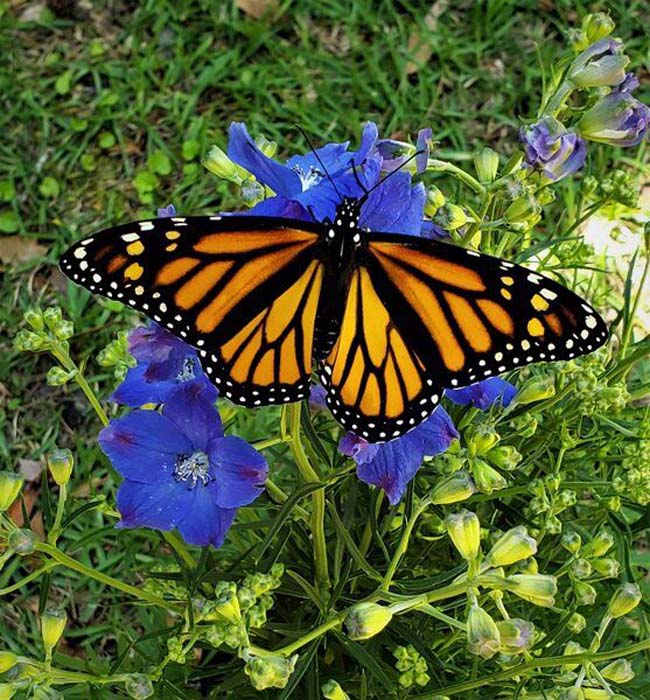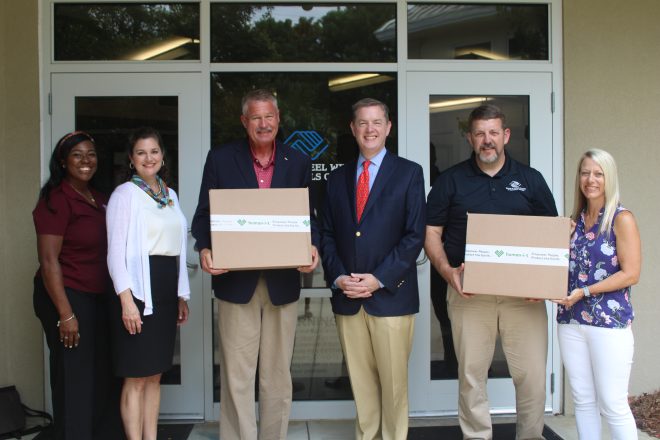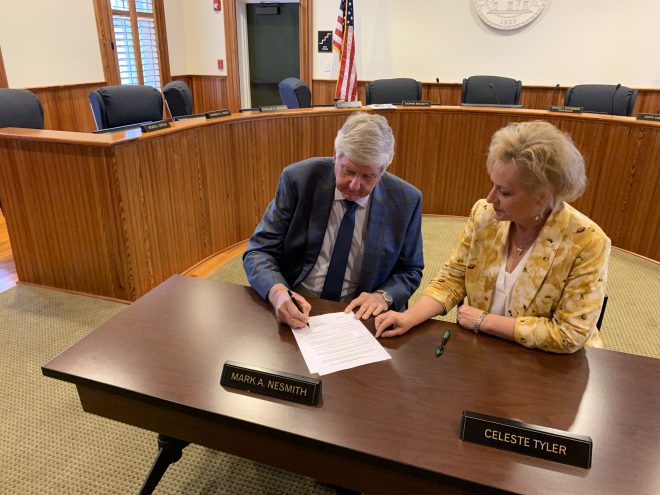Yarden Notes
Published 11:48 am Saturday, August 1, 2020

- Monarch butterfly photo by Tom Faircloth.
YARDEN AUGUST 2020
Sponsored by Thomasville Garden Club Inc.
Dear Readers,
Please do everything in your power to remain safe and well. As you know, confirmed COVID-19 cases are increasing rapidly in Thomas County. I hope that you are wearing masks in public, maintaining a safe distance from other people and abiding by all of the other recommended procedures to protect yourself, your loved ones and others. Continue revitalizing yourself by spending time outdoors, especially in your garden. Reap all those beneficial side-effects of gardening! Enjoy your beautiful flowers — not just as they bloom outside but bring them indoors to brighten your surroundings and lift your spirits, also. Please make good decisions during these bad times.
Wishing you and yours good health,
Pat Pankey
AUGUST WEATHER
The weather in August is usually very similar to July’s. Expect continued heat and humidity and plenty of rain. August’s average high and low temperatures are 92 and 71, respectively, with an average of 8 rainy days. In fact, from May to September, there is at least a 38 percent chance of a day experiencing rain, according to Weatherspark.com. Also, in the same period, the days are “muggy, oppressive, or miserable” at least 26 percent of the time. Again during the same period of time, the wind is calmer than at any other time of the year. Weatherspark.com suggests that beach/pool activities are best after mid-August, when temperatures begin to ease off a little bit and the chances for a clear day improve. This month, we receive 13.5 hours of daylight per day. That is 30 minutes fewer, per day, than in June and July, which provide the most daylight hours of the year.
HURRICANES
The first hurricane of the 2020 Atlantic season, Hanna, struck South Texas at the end of last month — Saturday, July 25, to be exact. By Sunday evening, it was downgraded to a tropical depression but still carried a lot of rain. Meanwhile, another possible tropical system could be in store, according to meteorologists.
Tropical storms and hurricanes are classified as such by their wind speed, not their size. A hurricane is first a tropical storm. Both storms start out as an unexceptional series of thunderstorms over the ocean. When conditions are right, a more serious storm develops. Here is a brief explanation of the development of a hurricane: If the ocean water temperature is at least 80 degrees, it warms the air above it. The warm air currents then rise and they lower the atmospheric pressure. If there is little wind shear (a change in wind speed and/or direction over a short distance), the area of low pressure pulls in more air, which, in turn, heats up, rises and adds to the low-pressure system. If this system grows large enough to enable its winds to twist around, it creates the start of a storm that swirls around an “eye.” This system grows into a hurricane if there is a continuous supply of energy from the warmth of the ocean water and from the warm, moist air that keeps rising, circling and building up strength and speed. When the winds that are associated with the storm exceed 74 mph, the storm is classified as a hurricane.
NOAA predicts an above-normal hurricane season this year. That means 13 to19 named storms (winds 39 mph or greater), 6 to 10 of which could become hurricanes (winds of 74 mph or greater), including 3 to 6 major hurricanes (category 3, 4 or 5, with winds of 111 mph or greater). FYI, an average hurricane season produces 12 named storms, 6 of which become hurricanes, including 3 major ones. The peak of the Atlantic hurricane season is from mid-August to late October. The Climate Prediction Center will update the 2020 Atlantic seasonal outlook in August prior to the historical peak of the season, so I will not be able to give you an update until next month. However, you can easily go online to find the results before then.
SPECIAL AUGUST DATES
Saturday, August 1 — One of the “four cross-quarter days” of the year. These are days that fall more or less half-way between an equinox and a solstice. This one is an old British festival called Lammas, which celebrates the wheat harvest. It falls between the summer solstice and the autumn equinox. The other three cross-quarter days are February 2 (Groundhog Day), May 1 (May Day) and October 31 (Halloween).
Wednesday, August 15 — Saturday, September 15 — I am not happy to report these dates but I think it is important to be aware that at this time of year, Southern mosquitoes are most active in Georgia. I want to remind you to prevent mosquitoes from making their home on your property and to prevent them from feasting upon you and your loved ones. I do not want us to be so wrapped up in the corona virus that we forget the viruses that are transmitted by mosquito bites.
SPEAKING OF MOSQUITOES
As so many others do, I have often questioned the purpose of mosquitoes. I read an answer to that in Smithsonian Magazine: They are an important part of the ecosystem. They are a vital part of the food chain, providing food for fish, birds, bats, frogs and adult flies, some of which are important pollinators. Yvonne-Marie Linton is the research director at the Walter Reed Biosystematics Unit and that unit curates Smithsonian’s U.S. National Mosquito Collection! Who even had an inkling there was such a collection? Anyway, she said that there are more than 3,500 species of mosquitoes but “only” 400 transmit diseases like malaria and the West Nile virus. She also said that most species don’t feed on humans at all! I think that all the ones that do must reside in the places I have lived!
IN BLOOM
All of the usual summer-flowering plants — annuals and perennials, flowers, shrubs and trees — are still blooming. Heat-tolerant plants, such as butterfly bushes, daylilies, lantana, melampodium, Mexican heather, pentas, purple coneflowers and sunflowers should still be performing, although they might be losing some of their pep due to the heat and humidity.
Later this month, we could be seeing spider lilies blooming. These are also called surprise lilies and are always fun to find because they bloom on long stems before any foliage is seen. All of the ones I have seen are red but they can also be yellow.
TO DO
If your annual flowers are, indeed, looking peaked, you can cut them back by about half, shape them, water well, fertilize lightly and then expect blooming to resume in about two weeks.
If you want a second crop of tomatoes, peppers and eggplants, remember that they usually require around 100 days to harvest. Therefore, it is probably best to transplant them into the ground around August 2.
I have found that planting guidelines show August to be the best month for us to plant fall crops of broccoli, Brussels sprouts, cabbage and kohlrabi.
You can remove faded crape myrtle blooms and seed clusters now. With adequate water and some fertilizer, more blooms are possible.
You can fertilize roses this month to stimulate new growth and more blooms in the fall.
Up until the end of the month, you can perk up your yarden by adding some late-blooming perennials to help it remain looking colorful and fresh. Some plants to consider are asters, black-eyed Susan, butterfly bush, hyssop (agastache), phlox, Russian sage and sedum. Ornamental grasses are also a good choice; their tall flower spikes add to their “airy beauty” at this time of year. And, if you have a bare, difficult spot, add a groundcover such as creeping phlox, creeping sedum or hens-and chicks. Ice plants are good for slopes. (I found these recommendations on costafarms.com) Just remember to keep an eye on new plantings; keep them well-watered.
AUGUST QUOTE
“A Garden Is a Friend You Can Visit Anytime” — title of a gardening journal/notebook with blank pages for writing notes; originally published in 2019 by 3 Rs Publishers.
Pat Pankey writes this column for Thomasville Garden Club Inc. as a service to the community. Thomasville Garden Club Inc. welcomes new members. If you are interested, please contact Membership Chair Julie Feinberg at (229) 224-5771 or any current member. The Garden Center has a library of books about gardening that are available not only to garden club members but also to the general public. To access the library or to visit the Garden Center, please contact Caroline Flowers at (229) 200-9197 or any current member. You may contact Linda and Joe Tarver at (229) 403-1187 if you are interested in renting the Garden Center for an event. The Garden Center is always open to the public on the Wednesday before the first Friday of every month, September through May. Please visit our website at www.thomasvillegardenclub.org and find us on Facebook.





